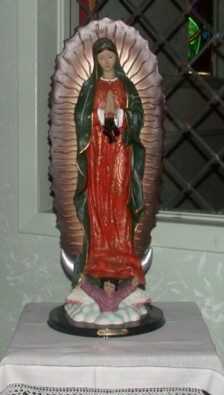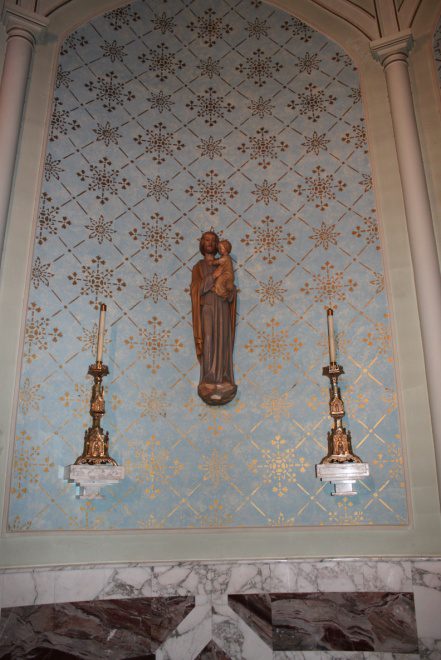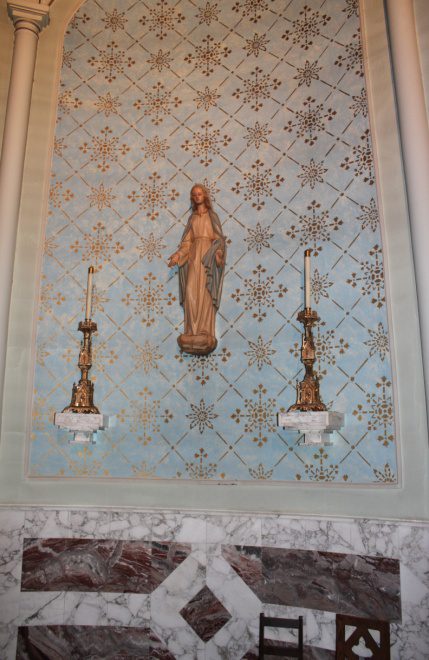Church History
The Rich History of Our Lady of the Lake Catholic Church

“Sancta Maria Ora Pro Nobis” Hail Mary, Pray For Us
Our Lady of the Lake Catholic Church, Lake Village, Arkansas located on Lake Chicot is dedicated to our Blessed Mother under the title, Our Lady of the Lake.
The words, “Santa Maria, Ora Pro Nobis” in Latin, found over the round-arched entry above the front doors of the church entrance translated are, “Hail Mary Pray for Us.”
The church, built on Italian lines, was constructed under the direction of the pastor, Reverend Edward N. Hinkley, in 1939 and dedicated by Rt. Rev. Bishop John B. Morris, the 3rd Bishop of Arkansas Diocese, in October of the same year. It replaced an older structure in Lake Village dating from 1866.
Headlines in the diocesan paper, “The Guardian” at the time were as follows:
“Our Lady of the Lake Centennial Celebrated 1866–1970”;
“The 100th Anniversary of the Parish was celebrated in 1970. Guest speakers and visiting clergy highlighted the centennial celebration of our Lady of the Lake last Sunday (Friday, Sept. 25, 1970).”
Principal celebrants of the Mass were Rev. Bernard L. Bolds pastor. Other celebrants were Father George A. Carns, Dermott pastor and former pastor at Lake Village; Rt. Rev. Msgr. Joseph Gallagher, dean of the Southeastern District; Rev. Jean Marie Germaine of Oak Grove, LA; and Rt. Rev. Msgr. Thomas Pendergast of North Little Rock.
Special guests present were the Rt. Rev. Albert L. Fletcher, Bishop of Little Rock, and Rt. Rev. Msgr. Lawrence P. Graves, auxiliary Bishop. Rt. Rev. Msgr. Joseph Murray was master of ceremonies, and Bishop Fletcher read the homily. The commentator was Joe T. Reilly of Greenville, Mississippi, grandson of Mrs. Joseph Bertram Johnson, founder of “St. Mary’s of the Lake.” The name was later changed to “Our Lady of the Lake” in 1869.
The Centennial Book is available in the book section of our website. It has a detailed history of the church and is a must-read. There are also other books that will interest you about the history of our church and the Italian immigration to Sunnyside.
Southeast Arkansas was just as remotely removed from the nearest Catholic communities at Arkansas Post and Pine Bluff as it was from Greenville, Mississippi. Diocesan boundaries were not considered by the early bishops and priests in their efforts to convert souls to Christ and to administer to the needs of the scattered families. The distance from Lake Village to Greenville was only about a mile as the crow flies. Because of the bends, which existed in the Mississippi River at that time, one could paddle across the river, pick up his skiff, walk across a narrow neck of the land, put his boat back into the water, and paddle a little more. Greenville had accommodations for a priest, but Southeast Arkansas had neither church nor rectory.
At this time, Mrs. Joseph Bertram Johnson (Katherine Kiernan) began pleading with the Bishops of Arkansas, Mississippi, and Louisiana for the establishment of a Catholic mission in Lake Village. They worked hard and held strawberry suppers to help raise funds. Services were held in homes until they acquired a site adjacent to the holdings of their parents, and built a white-framed church on the banks of Lake Chicot (then known as Old River). It was dedicated in 1869 as Saint Mary’s of the Lake.
The mission of the church was at that time beyond computation, but regular services were held at Sunnyside: Hyner, Cottonwood, and Hebron. Even areas as remote as Lakeport, Clover, Eudora, Luna, and Readland were included in converting souls to Christ and administering to the spiritual welfare of the families.
Although many have read stories of Father Frank Joachim Galloni reaching the faithful by horse in the early years, Father Joe Friend, present pastor at Our Lady of the Lake Church, has no horse but continues work like in the past. He serves missions at Holy Spirit Church in Hamburg, and Holy Cross Church in Crossett, Arkansas. Missionary Carmelites reside and serve in Hamburg, Arkansas.
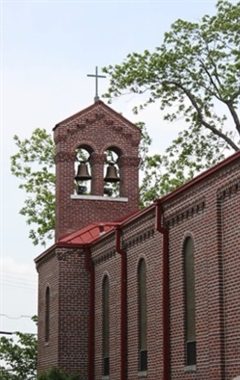
Bell System of Our Lady of the Lake Church
The church bell system was installed at our Lady of the Lake Church in 1966 by Rev. Bernard Bolds, the resident pastor from 1948 to 1973. His love for the church and classical music was his obsession. He worked hard to raise money for the purchase and to have the system installed.
He had hundreds of beautiful hymns played 15 minutes on every quarter of an hour. Although some of the neighbors and townspeople complained, they became accustomed to it and missed the music, if by chance it was not played.
Father Bolds loved his system so much that converts had to endure much longer sessions of learning the faith. He would keep them hours longer to have their company in listening to strains of “Mule Train” by Frankie Lane, and other similar songs by various artists of that era. Father Bolds played them so loudly it was heard all over town, and if the winds were right, even across the Lake Chicot.
These sessions that generally lasted less than a year were extended as much as two years for some. They said that Father Bolds needed to share what he perceived as a wonderful gift not only for himself but for others as well. As he listened, he would close his eyes and sit quietly with them.
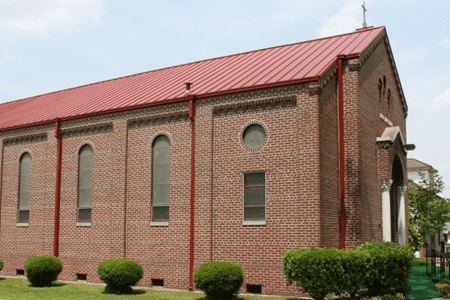
Our Lady of the Lake Architecture
The basic architecture of the renaissance was the adaptation of the classical with balanced columns, domes, and symmetrical facades. The rounded back, as you see on Our Lady of the Lake, accommodates the same in the front apse—there is no spring point. This circular form often appeared in architecture, especially Byzantine. Romanesque was the dominant architecture in Europe during the 8th to 12th centuries. It was characterized by Roman precedents, particularly arches and barrel vaults, as evidenced here.
Architecture of Our Lady of the Lake Church
When Our Lady of the Lake Catholic Church was built in 1939, it was constructed on the beautiful Italian lines of masonry and concrete. Its exterior was faced with blended shades of red brick. The steps, columns of the front entrance, windowsills, and panel above the front entrance were all carried out in cast stone. Steel trusses support a standing seam metal roof. Its windows are of Cathedral art glass. The nucleus of the building fund was done with $5,000.00, bequeathed by Father F. J. Galloni for the erection of a new church. The rest of the cost of $30,000.00 was carried out with the enthusiasm and cooperation of the parishioners of Our Lady of the Lake Parish.
The Gothic style of architecture and interior design came to be the norm in Europe in the thirteenth century. The basic elements include a flood of sunlight illuminated through windows, an abundance of decoration, and the use of arches, buttresses, and vaulted. Verticality was symbolic of the ethereal or heavenly. Excerpts have been adapted from thesis Architecture of St. Mary’s Catholic Church by Laura Robertson, Dumas, Arkansas.
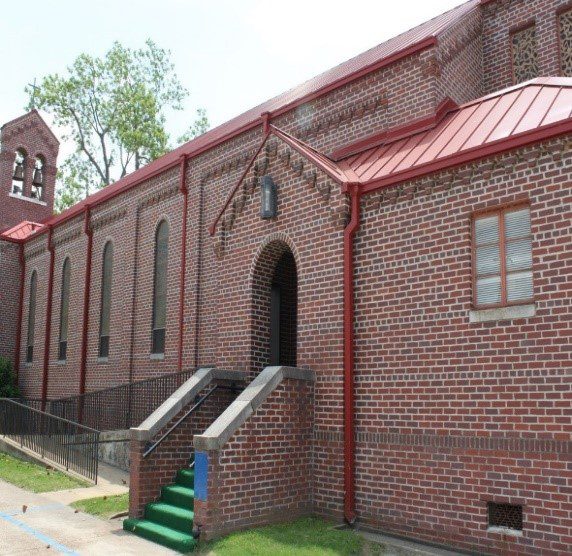

The colors in the sanctuary and church of blue and green were chosen for the promotion of peace, serenity, tranquility, and a spirit of reverence. They were also chosen to blend in and complement all the liturgical colors of the church. The green carpet was chosen because it is the color of all the earth’s living things and blends with every color of flowers in the world.
After the painting had been completed, the designs in the tabernacle area were done by stenciling; a design was cut out of heavy paper, painstakingly and accurately placed over the walls, then painted, and removed.
Marble was chosen for the altar because in biblical times, the altars of sacrifice were made of stone. According to the Bishops’ liturgical directions, it should be made of stone whenever possible. The Italian white was the color chosen to complement the church’s colors and used for the tabernacle, baptismal font, and the lectern stands.
The top of the tabernacle was donated by the Borgognoni Family. The arch and crucifix were donated by the Howsen Family in memory of Roy and Linda Howsen.
The lights on one side of the church were donated by the Borgognoni family in memory of their brother, Alex Borgognoni, and the other side in memory of their father, Joe Borgognoni, Sr. around 1962. The new Rodgers organ was purchased by Father Bolds for the church in the 1960s.
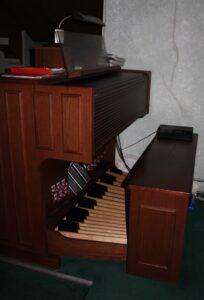
Rodgers Organ Purchased by Father Bolds in the 1960s
One of the most popular organs found in churches and homes alike is the Rodgers organ. Their history includes the manufacturing of both church and theatre organs. The all-transistor oscillating circuit was developed in 1956 by a team that included Rodgers Jenkins and Fred Tinker. This was in conjunction with Tektronics, a company that had no interest in building electronic organs. In 1958, Tektronics’ officers personally funded the creation of the Rodgers Organ Company with Jenkins and Tinker named the managing officers.
In 1961, Rodgers introduced the first single-contact keying system on any organ, pipe or electronic, and in 1962, introduced reed switch pedal keying. However, Rodgers’ first completely transistorized organ, which completely eliminated vacuum tubes, also appeared in 1962, and thus, was the first solid-state organ in history. In 1965, the Rodgers Trio theatre model was introduced and became the largest-selling three-manual organ of all time. This model was manufactured with revisions in specifications over the years until 1982.
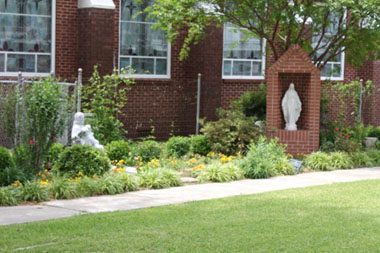
The Grotto of the Blessed Virgin Mary was established by Associate Priest Father Johnson Peramangalath in June 2002.
You can create your own prayer garden at home. Choose from the statues of St. Joseph, St. Francis of Assisi, the Virgin Mary, angels, or cherubs. Many roses have names appropriate for a prayer garden: Peace, Emanuel, Joanne d'Arc, Joseph's Coat, Compassion, Sympathie, Brother Cadfael, Easter Morning, Pleine de Grâce, and Our Lady of Guadalupe.
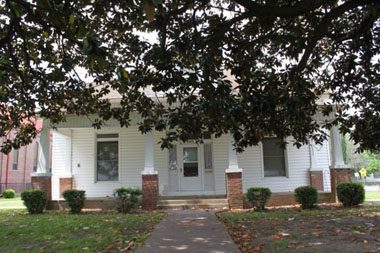
Original Sister’s Home in 1914
One of the goals of the Catholic Church was to establish the best of religious and secular education from kindergarten through college to not only Catholic children but to all others who desired the quality received in the schools.
St. Mary’s School was founded in 1908 by Father Matthew Saettelle. He brought in additional Benedictine Sisters from St. Scholastic’s Convent in Fort Smith, Arkansas who devoted their lives to the welfare as well as the educational and spiritual good of the parish and community. The Sisters worked under adverse circumstances during the early formation of the school and the church until 1987.
Students who have graduated from St. Mary’s consistently set the standard for others at the schools they attended after leaving St. Mary’s. They were taught the values of others, respect for everyone, and that God is and should be number one in their lives.
The community was saddened when the school was closed down in 2015 after serving the church for 107 years.
In the year 2020, it was apparent that the convent house built in 1914 by Father F. J. Galloni, for the Sister’s home and after 1987 used for classrooms, had deteriorated to the point of extensive and costly repairs, in addition to the need of removing the asbestos roof. After much consideration the consensus culminated in having the building demolished.
Father Stephen Hart stated: “We should pray to the Lord, asking that he may reveal his will to us about the future of the space and that he may abundantly bless us through the intercession of Mary, his mother, and Saint Isidore the Farmer for guidance in this matter."
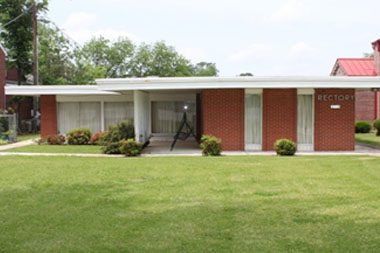
This rectory was built in the 1960s, and for many years, the priests of our Parish have resided at the Rectory. Currently, it is used as the parish office, meeting rooms of the church organizations, and houses the Our Lady of the Lake Historical Museum.
The museum is the accomplishment of the lifelong dedication and work of Libby Borgognoni who has been writing and collecting the history of the church since 1966 and the Italians of Sunnyside as well. Tony Pete and Libby Borgognoni, patrons of the museum, saw it come to fruition when the museum was dedicated on Sunday, May 25, 2011 by Father Theo Okpara.
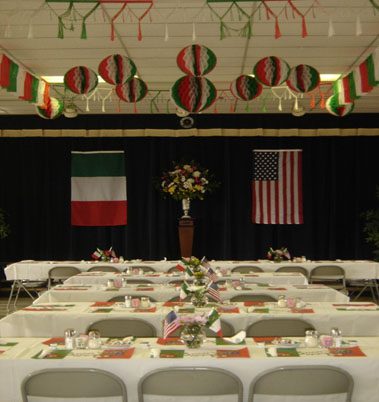
100th-Year Spaghetti Dinner Held in 2010
The oldest organization in the parish is probably the Our Lake of the Lake Altar Society, believed to have been founded in the early 1910s. It was also known as the “Sodality of the Blessed Virgin Mary” in the early 1930s. Some of their duties are keeping the altar linens, priest and altar boys’ vestments, candles, and wines, and ensuring that sanctuary needs are filled and in order. They prepare meals for first communions, confirmations, weddings, funerals, receptions, and visits of the Bishop, to mention a few. Many hours are donated each day and week of the year by this organization. They have held an annual homemade prepared Spaghetti Dinner on the first Sunday of March every year since 1910. It is their dedication that plays a pivotal part in the “giving heart” of the church.
The 100th year of the ladies having their annual spaghetti dinner was in 2010. This dinner usually serves around 1,500 people and is their annual fundraiser for this organization. It also used for special occasions, such as parish potlucks and other functions of the parish and its parishioners as well as for many community purposes.
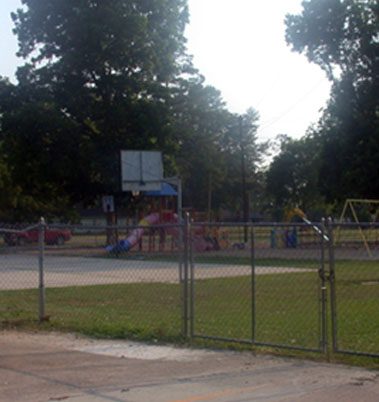
Original Church Site
The basketball court adjacent to the school’s playground was built in 1960 by Tony Borgognoni and Melvin Cannatella.
Formerly, the original church, known as St. Mary’s of the Lake and built in 1869, was renamed Our Lady of the Lake in 1896. It was the oldest building on church grounds and was moved to this site in 1939 to serve as the parish hall when the present new church was built.
The old church was torn down in 1965 after the current Parish Hall was built and replaced by this court for schoolchildren.
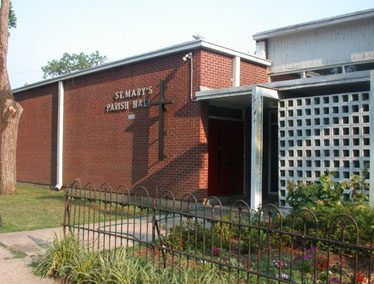
When the new brick church was built in 1939, the original church built in 1869 was moved from the lakefront and used as a parish hall and cafeteria. It was razed in 1965 to make room for the above parish hall and cafeteria that we use today.
The Parish Hall was used daily for lunches served to the children of St. Mary’s School until the school closed in 2015. Today, it is used for multiple functions of the parish and community.
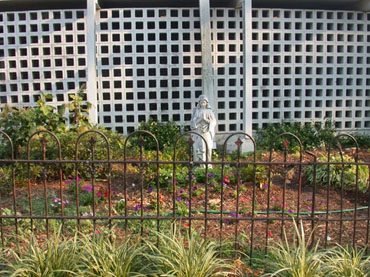
Statute of the Blessed Virgin Mary in the courtyard garden of the Parish Hall.
There are over 600 names for the Blessed Mary; she is known by many titles (Blessed Mother, Virgin, Madonna, Our Lady), epithets (Star of the Sea, Queen of Heaven, Cause of Our Joy), invocations (Theotokos, Panagia, Mother of Mercy), and other names (Our Lady of Loreto and Our Lady of Guadalupe).
All of these titles refer to the same individual named Mary, the mother of Jesus Christ (in both the New Testament and Qur'an) and are used variably by Roman Catholics, Eastern Orthodox, Oriental Orthodox, and some Anglicans (Note: Mary Magdalene, Mary of Clopas, and Mary Salome are different individuals from Mary, mother of Jesus.)
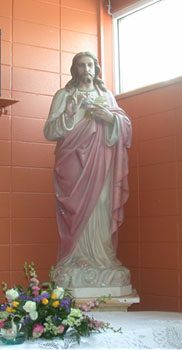
The Sacred Heart of Jesus statue was originally in the church before the redecoration in 1982. It is now placed in the parish hall near the stage.
The Sacred Heart of Jesus was one of the first orders of the Catholic Church and was instrumental in influencing and spreading the church’s beliefs.
Introduction of History of Our Lady of the Lake Catholic Church Libby Borgognoni, Historian
STATUES IN VESTIBULE AND SANCTUARY:
The Statues, purchased in 1939 when the new church was built, now in the Vestibule-Cry Room, of St. Anthony of Padua and Saint Isidore were donated by members of the parish in memory of deceased loved ones and in honor of the saints depicted. The Infant of Prague was donated by Ned and Nedina Reginelli. Those of Jesus, Mary and Joseph were on either side of the crucifix in the nave of the sanctuary until the renovation in 1981 when they were moved to the vestibule. In 2006 and 2007 the above statues were restored to their original beauty by Jennifer Carman, “J Carman, Inc. Fine Arts” of Little Rock, Arkansas.
On the right side of the entrance is a painting of the Hand of God The Father, the Heart of Jesus and the Dove for the Holy Spirit painted on the spot by Mr. Matt Peterson who renovated the church in 1981. Underneath sits a Holy Water Font donated by the August and Nazzareno Catalani families. Originally, it served as the Baptismal Font until the renovation of the church.
In 1981 the new crucifix hanging over the tabernacle in the sanctuary today was donated by Joe Borgognoni, Jr. The statue of Mary was donated by Buster Sabbanti, in memory of his wife, Virginia Pesaresi Sabbatini. The statue of St. Joseph was donated by Joe Pieroni in memory of his wife, Ollie Mae Allumes Pieroni. The crucifix and the two statues were made in Italy hewn from solid wood and painted by artisans there. These were purchased to enhance the new decor of the church's renovations and the original statues of Jesus, Mary and Joseph put in the vestibule.
The Statue of the Sacred Heart on the left side over the organ near the rear entrance was also made in Italy of wood painted by artisans there. It was brought by Mr. Petersen in the hopes that someone would buy it; but when the church was finished it had not yet been purchased, so he donated it as his personal gift to Libby Borgognoni for her assistance during the renovations.
The second organ (Allen) was donated by the family of Maxine Cochran and Marilyn Jo Borgognoni, who served as organist for over 50 years at Our Lady of the Lake, in memory of Mrs. Cochran.
The fourteen Stations of the Cross on the walls of each side of the church were probably placed in the church in the 1940's. They are of alabaster, a translucent, whitish, fine grained variety of gypsum. Mr. Petersen took each one and repainted them with an air brush depicting Christ with a gold halo over his head. We were very blessed to have him do these for us free of charge, and we were fortunate to have his talents used here because he was 75 years old at the time. Upon his retirement his son was eventually going to take over the Church Decoration business, Church Decorating Service of South Bend, Indiana, that was founded by Matt Petersen's father about 1906.
Easter Season of Our Lady of the Lake Sanctuary
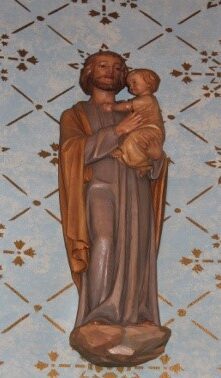
St. Joseph Holding Infant Jesus

Crucifix: Hanging Over
the Tabernacle

Blessed Virgin Mary
Rotunda View of Sanctuary
AMBRY: Purchased During the Pastorate of Father Erik Pohlmeier
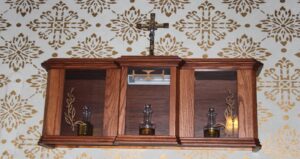
The Crucifix was donated by the Howsen family in memory of their parents: Linda and Roy Howsen
The Ambry is housing for the holy oils called chrism. Chrism is essential for the Catholic Sacrament of Confirmation/Chrismation, and is prominently used in the sacraments of Baptism, Holy Orders and Anointing of the Sick and is also used in the consecration of objects such as churches and altars. Chrism is made of olive oil and is scented with a sweet perfume, usually balsam. Chrism is blessed by the bishop every year at the Chrism Mass, which usually takes place on Holy Thursday or some other day of Holy Week.
The three oils are — the oil of catechumens (oleum catechumenorum or oleum sanctorum), the oil of the infirm (oleum infirmorum) and holy chrism (sacrum chrisma) — which will be used in the administration of the sacraments throughout the diocese for the year. Pope Pius XII issued a new Ordinal for Holy Week, which reinstituted a special Mass of the chrism distinct from the evening Mass. These holy oils are usually stored in special vessels known as chrism aria and kept in a cabinet known as an ambry. When the oils are distributed to a priest for him to use in his ministry they are kept in a smaller vessel with three compartments.
Pastoral Seating

The presidential chair in a parish is the seat placed prominently in a presiding position for the use of the priest. This is flanked by two chairs for altar servers who assist at Mass.
Glass Windows In Sanctuary
Hand Crafted by Matt Petersen

Windows: Upper right and ledt of inside rotunda
Matt Petersen took colored pieces of broken glass, placed them, as shown, in a metal encasement made to the exact size of the window openings, and poured an epoxy resin around them to harden and dry for the sanctuary.
The Tabernacle
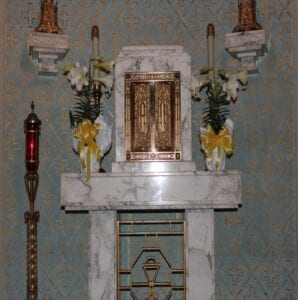
On entering a church parishioners genuflect, or bow if unable to kneel, toward the tabernacle that holds the consecrated host, in order to acknowledge respectfully the presence of Jesus in the Blessed Sacrament, a presence to which a red votive candle or sanctuary lamp kept burning close to such a tabernacle draws attention. The tabernacle is placed in the center of the sanctuary.
Adjacent to the Sanctuary
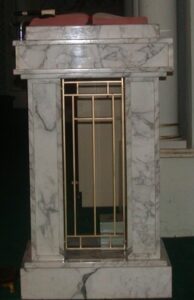
Lectern or Ambo
The lectern or ambo is the place from which the word of God is proclaimed. It is a stationary reserved reading stand, for scripted readings, responsorial psalms, homily and general intercessions.
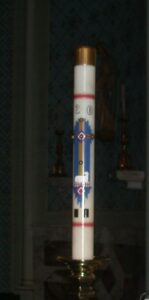
The Paschal or “Easter Candle”
The Paschal Candle stands as a striking symbol of the Risen Christ, Light of the World. It remains near the ambo (lectern) until Pentecost and is kept near the baptismal font through the year.
Sacred Heart of Jesus

The statue of the Sacred Heart of Jesus was donated by Matt Petersen to Our Lady of the Lake Church,
as a gift to Libby Borgognoni for her assistance in redecorating the church in 1981-1982.
The Statues in the Vestibule Cry Room

Donated by Our Lake of the Lake Parishioners
Restored Gift of Tony and Libby Borgognoni
Anthony of Padua or Anthony of Lisbon (born Fernando Martins de Bulhões; c. 1195–13 June 1231) was a Portuguese Catholic priest of the Franciscan Order. Though he died in Padua, Italy, he was born to a wealthy family in Lisbon, Portugal, which is where he lived most of his life. Noted by his contemporaries for his forceful preaching and expert knowledge of scripture, he was recognized as a saint almost immediately after his death and proclaimed a Doctor of the Church in 1946. Next to Mary of Nazareth, the Saint most often seen in artwork holding the child Jesus in his arms is St. Anthony of Padua. Saint Anthony is of importance in our community as being represented in both stain-glass and statue form.
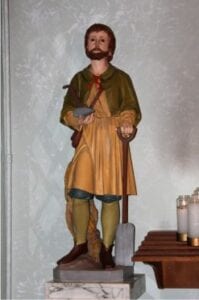
Donated by Our Lake of the Lake Parishioners
Restored Gift of A and B Pieroni Families
Prayer: God, through the intercession of St. Isidore, the Holy Farmer, grant that we may overcome all feelings of pride. May we always serve you with that humility, which pleases you, through the merits of St. Isidore. Saint Isidore has been previewed both in stained glass and in statue form. Father Galloni established Saint Isidore as the patron of the church cemetery for the many farmers of the parish and their devotion held for this saint.
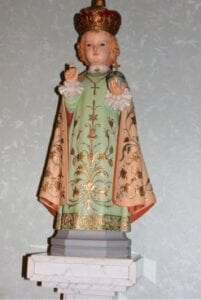
Gift of Ned and Nedina Reginelli
Restored Gift of Roger and Vickie Hensley Family
Prague is the capital city of the Czech Republic, which is at the very center of Europe with Germany, Poland, Russia, and Austria as its neighbors. The history of the Infant Jesus of Prague started in the 17th century when a statue of the Infant Jesus was brought into Bohemia, now the Czech Republic, and eventually was given to the Discalced Carmelites in Prague. Since then, the statue has remained in Prague and has drawn many devotees worldwide to go and honor the Holy Child. Many graces, blessings, favors, and miraculous healings have been received by many who petitioned before the Infant Jesus.
Saint John Paul II: The 262nd Pope
12th of the 263 Popes reigned during the history of Our Lady of the Lake Catholic Church 1866-2012
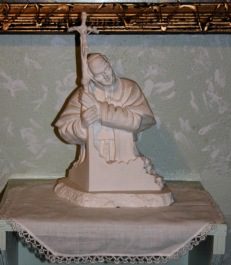
Blessed Pope John Paul II was born in Wadowice, Poland on 18 May 1920 as Karol Józef Wojtyła and died on 2 April 2005. He was elected Pope on 16 October 1978, and served for 27 years. As Pope, he was the head of the Roman Catholic Church and the Sovereign of Vatican City. Pope John Paul II "succeeded" Pope John Paul I who died suddenly. John Paul I was pope for only 33 days. Pope John Paul II was the first non-Italian pope in 455 years. Pope John Paul II travelled more than any other pope before him, visiting many of the countries of the world. He is also famous for starting the annual World Youth Day. After he was beatified on May 1, 2011, his title was changed to Blessed John Paul II, and canonized as Saint John Paul II on April 27, 2014.
Statues in the Alcove of Vestibule
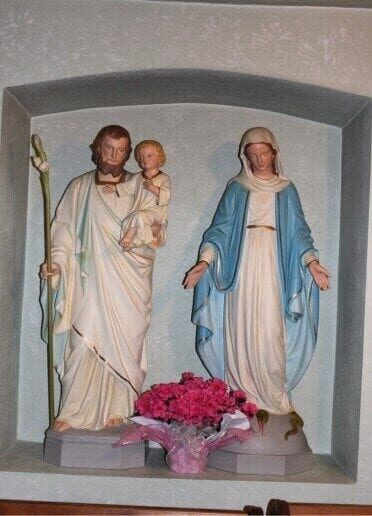
First bought by parishioners of Our Lady of the Lake. The Blessed Virgin is a restored gift of Joe Borgognoni, Jr. Saint Joseph with infant Jesus by his side was a restored gift of parishioners of the church.
Right-side Upon Entrance of the Vestible

The painting of the Hand of God the Father, the Heart of Jesus, and the Dove for the Holy Spirit was painted on the spot by Mr. Matt Petersen who refinished and redecorated the church in 1981.
For Catholics, the Sacrament of Baptism is the first step in a lifelong journey of commitment and discipleship. Whether we are baptized as infants or adults, Baptism is the Church's way of celebrating and enacting the embrace of God.
Holy water font or stoup is a vessel containing holy water generally placed near the entrance of a church. It is used in the Catholic Church and some Anglican churches to make the Sign of the Cross using the holy water upon entrance and exit. Holy water is blessed by a priest, and Catholics believe it can repel evil and cleanse venial sins, although its primary purpose is to remind people of their baptism.
For Catholics, the sacrament of baptism is the first step in a lifelong journey of commitment and discipleship. Whether we are baptized as infants or adults, baptism is the church's way of celebrating and enacting the embrace of God.
Our Lady of Guadalupe
Donated by the Hispanics of the Church
The first appearance of Our Lady of Guadalupe was on the 9th and 12th of December, 1531, in Tepeyac, a poor area in Mexico City. She appeared first to Juan Diego, then his dying Uncle Juan Bernardin, whom she healed. She miraculously painted herself on the mantle of Juan Diego. The icon remains in the basilica of Our Lady of Guadalupe at Tepeyac where millions from the Americas and around the world go on pilgrimage every year. Her feast day is December 12. Her message was of love, compassion, and hospitality.
An incredible list of miracles, cures, and interventions are attributed to Our Lady of Guadalupe. Yearly, an estimated 14 million pilgrims visit her basilica, making the shrine of Our Lady of Guadalupe in Mexico City the most popular Marian shrine and the most visited Catholic sanctuary in the whole world.
